
Here is a Quiz: What do the following events have in common?
· A tragic gunfire event in a small town church in Texas that raises again the debate about gun use and ownership in the USA.
· The death of a college student at a party that draws the attention to binge drinking, hazing, alcohol and drug consumption and campus rape
· The accusations of sexual harassment against a Hollywood producer that triggered the twitter hashtag “Metoo”, which then led to a barrage of other similar accusations by a variety of women, and some men, against several actors, comedians, politicians, and sport coaches, all of which highlighted conditions of silent acceptance with which society has responded all too often
· The recent comment of North Korean’s President Kim Jong-un referring to President Trump as “old” triggered Trump’s reply tweet “I would NEVER call him ‘short and fat’”, in a verbal child-like spat that wouldn’t be serious were it not for the fact that these two individuals have the decision power to launch us all into a devastating nuclear war.
On a recent NPR radio show about the news of the week a listener called in and shared a perspective that gave me pause. The topic being discussed was the current multitude of sexual harassment incidents but the listener’s comment however was more encompassing. Gun use and ownership, college hazing and rape, sexual harassment and threats of nuclear aggressions are all based on an overpowering masculine energy. We need to reflect how we are raising our boys, she said.
This reminded me of a key element in my research about what makes for a sustainability mindset. Concerned with the slow pace observed in changing behaviors that can move us from un-sustainability to a flourishing planet, I studied motivations of individuals that began to act with the global wellbeing in mind. Connecting the various elements that I found in my research, there was an overarching umbrella: these individuals portrayed a balance of their yin-yang, their masculine and feminine energy.
Let me explain this. Beyond our gender identification, we embody two streams of energy: the masculine and the feminine. The masculine energy pushes towards action, towards confrontation. It is at the root of our impulses to compete, to measure and prove who is stronger, and it thrives on making power visible. In its more ancestral form, it is meant to protect self or the tribe, defending them from aggressors, and seeking immediate survival with a focus mostly on the short term.
The feminine energy on the other hand seeks nurturing and caring. It is at the root of our cooperative and compassionate actions. It helps us connect with others through empathy, puts ourselves in the other person’s shoes; it is interested in the longer term, given the ancestral feminine duty of bearing children and ensuring they learn what they need as they grow up.
Like breathing in and out, it is not an either-or option. We need both energies. However, culturally we have been fragmenting the whole, and promoting the masculine energy in boys and men, the feminine energy in women, all the while discouraging the expression of the complementary energy in both genders. Sociological and anthropological studies have long shown that this is not a characteristic of humankind, but a cultural choice, that has just taken prominence, to the point that it is taken as “the way it is”. However, there have been findings of thriving civilizations that had a more energy-balanced approach, i.e. the Catal Huyuk, in Anatolia (today’s Turkey), considered one of the first cities in the world, the Southeastern and Mediterranean between 7600 and 5000 BC, the city of Ladakh in Northern India. In those cases, tasks and roles were distributed by skills and physical abilities, not by gender. Overall, they became successful civilizations, with survival competencies based on collaboration and support of activities for the benefit of the whole group. These civilizations came to an end when they were overpowered by masculine-driven conquerors, albeit it is noteworthy that they were able to last for several thousands of years in some cases.
Fortunately, we are part of an evolution, and while masculine energy still dominates the landscape, the cultural fragmentation of what is promoted and discouraged in either genders is changing. Women in Saudi Arabia are now being allowed to drive, in many places men are encouraged to express their tenderness and compassion (i.e. new parenting behaviors of the younger generations; organizations offering paternity leave); women are stepping into the public sphere with more active roles, and little girls are told that they can be anything they want. While this may refer to occupations and careers, it transcends into the permission to tap into the available masculine and feminine energy.
I find it interesting that this push towards a more balanced use of our energies is being prompted at the same time on many fronts. Take the sustainability challenge for example. Illness due to air pollution is prompting us to seek alternative industrial practices: the masculine short-term thinking (profits now) is replaced with a feminine long-term thinking: we incur additional costs now but we will benefit from health in the longer term. Or the masculine self-centered thinking (it is good for me, for our business) is replaced with a more encompassing (feminine) perspective: if we make our clients sick, we all lose. From a social and market side, many industrial challenges (i.e. the popular demand for preserving the rain forests, questioning the use of palm oil) cannot be solved individually (masculine energy: competition), but require collective actions (feminine energy: cooperation). The widespread images of the Syrian or Rohingya refugees brings in front of our eyes the details of a reality that was more easily ignored when we didn’t see it from so close, and prompts feelings of empathy and compassion (feminine energy) that conflicts with protection of exclusion tendencies (masculine energy).
The predominance given to the masculine energy is showing up in more visible consequences: our short-term focus has created many planetary challenges; our fight-or-flight has brought pain and destruction; our greed-based growth and individualistic consumption is having a toll that we can actually see. The messages that are pushing us collectively are coming from many sides: it is time to open up to the feminine energy we all carry, and find in that voice inside ourselves the wisdom for a peaceful, just and healthy planet. People included.

